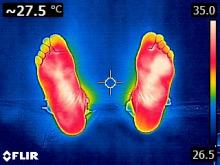Routine infrared dermal thermography for early diagnosis of high-risk diabetic foot

| Type | Start | End |
|---|---|---|
| Other | Jan 2023 | Dec 2025 |
| Responsible | URL |
|---|---|
| Veronica Vilaplana |
Reference
Project ID UPC: C-12429 (IDIAPJGol)
Project ID UPC: C-12428 (IDIBELL)
Description
Diabetic foot (DF) is a localized lesion in the skin and/or underlying tissue, below the ankle, in a person with diabetes mellitus (DM) due to diabetic neuropathy (NP) or peripheral arterial disease (PAD) or both.
The most effective preventive measures to prevent DF are: the implementation of a screening program, systematic risk stratification for ulceration, patient and family health education focused on empowerment and self-care and an efficient integrated primary care and hospital system.
There are different risk stratification systems, such as: the one proposed by the International Working Group on the Diabetic Foot (IWGDF) and the one proposed by the National Institute for Health and Care Excellence (NICE).
Screening includes foot inspection, NP assessment, and PAD assessment. Non-invasive hemodynamic tests are the mainstay of vascular assessment for most patients with chronic lower limb ischemia. However, current non-invasive arterial tests, such as the ankle-brachial index (ITB), are not reliable in patients with significant arterial calcifications, which occurs in one-third of patients with DM.
Given the need to improve screening tests to reduce lesions and amputations, the use of infrared dermal thermography (TDI) has been shown in initial studies to be a diagnostic tool to complement the screening and stratification of DF. Its use in screening for DF risk factors can improve risk stratification by increasing the detection of subclinical NP and PAD and reduce complications.
The objective of this study is to evaluate the diagnostic validity of routine TDI in the early diagnosis and stratification of high-risk neuropathic, neuroischemic, or subclinical angiosomal (distal angiopathy and distal PAD) DF in the primary care setting.
The study population will be patients with a diagnosis of type 2 DM (DM2) from the Primary Care Teams (EAP) of the Catalan Institute of Health (ICS) in the towns of Gavà, El Prat de Llobregat, Viladecans, Castelldefels, Begues, and the central and southern areas of Hospitalet de Llobregat.
It is expected that it will be able to detect angiosomal disorders in the feet, which due to the characteristics of the patient with diabetes (calcification) are not detected in the usual screening tests in primary care. Improved screening can increase the number of cases detected of secondary cardiovascular prevention in patients with DM (estimated at 30% underdiagnosis of PAD due to false negatives of the ABI technique).
GPU is collaborating in this study conducted by the Chronic and Complex Wounds Research Group (GReFeC), the Diabetic Foot Functional Unit (UFPD), and the Angiology and Vascular Surgery Service (ACV) of the Bellvitge University Hospital (HUB) of the Metropolitan South Territorial Management (GTMS)
Collaborators
| Veronica Vilaplana | Associate Professor | veronica.vilaplana@upc.edu |
| Montse Pardàs | Professor | montse.pardas@upc.edu |
| Maria Ysern | PhD Candidate | maria.ysern@upc.edu |
